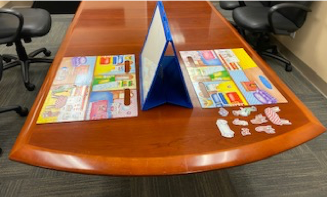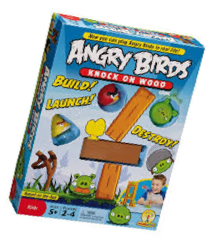Building Language Through Barrier Games
By: Carrie Dishlip, MS CCC-SLP
 Barrier games are a great, playful way to work on building both receptive (language comprehension) and expressive (language use) skills. Traditionally, barrier games are played between two people (or teams) with a visual barrier separating each side. You can create a barrier with a large book, a folder, a white board, a door, or even by sitting back to back with no peeking! Barriers block the materials but allow for eye contact and other non-verbal language cues. Each person has duplicated materials. Materials can be two- or three- dimensional. Usually, the first person creates a scene then gives directions so the other person can replicate that scene. At the end of the series of turns, you can compare and see how accurately the directions were given/followed. Then the roles can be reversed to continue the interaction.
Barrier games are a great, playful way to work on building both receptive (language comprehension) and expressive (language use) skills. Traditionally, barrier games are played between two people (or teams) with a visual barrier separating each side. You can create a barrier with a large book, a folder, a white board, a door, or even by sitting back to back with no peeking! Barriers block the materials but allow for eye contact and other non-verbal language cues. Each person has duplicated materials. Materials can be two- or three- dimensional. Usually, the first person creates a scene then gives directions so the other person can replicate that scene. At the end of the series of turns, you can compare and see how accurately the directions were given/followed. Then the roles can be reversed to continue the interaction.
Language goals of barrier games:
- Improving vocabulary and word finding challenges by using specific words (nouns, attributes, location, perspective)
- Giving commands or directives with specification
- Increasing understanding of basic concepts
- Improving ability to follow simple to complex directions
- Turn taking, waiting, using eye contact and other early social skills
- Building visual perspective taking which means needing to consider what another person can see from a different point of view.
- Improving Theory of Mind skills such as “seeing leads to knowing”
- Body awareness (right/left) and social awareness (perspective taking, how much information is needed for someone to visualize the same thing as you)
- Discussion and reflection on an activity (what went well, what could you change)
Examples of barrier games:
- Construction

- Give each side 3-5 matching blocks, legos, Unifix cubes, etc. The first team creates a tower then tells the other team how to make theirs match.
- Provide materials for a simple craft (maybe with choices in colors for the same item, e.g. blue hat and green hat). The first team creates the craft and explains to the other side how to do theirs. A variation would be to have the visual model from the box for the first team then the other team does the crafting.
- Building from a visual can be a more complex way to do construction barrier games. Games like “Angry Birds Knock on Wood” provides visual scenes that the first team can describe while the second team builds. If there is only one set of materials available, then the first team can build and take a camera photo before deconstructing. Then they can use that photo to give the directions to the second team. You can add a pretend play element by playing “architect and construction worker” working to create a building with pillows or foam blocks … then both teams can join together for “demolition”.
- Make it Match
- Take two matching coloring book pages, give simple directions using color words when both teams have matching crayons.
- Start with a simple reference point, like a square in the middle of a page, and a set of matching stickers. Give directions to make the pictures match at the end. This can be done as a drawing activity as well.
- Using dough or clay, create an animal and describe to the other team to make it match.
- Any duplicate toys can be used for make it match games – Potato Head, Dress up Dolls, Superhero scenes
- Story Scenes – give matching scenes from a book or story then use stickers or magnets to create the same scene. Both teams can then work together to tell a story after as a language expansion activity
Supports:
- Start with buddies or teams to introduce the concept of barrier games.
- Younger children may do better with a side-by-side barrier so they don’t have to navigate left/right reversal concepts.
- Comprehension usually comes before expression typically, so practice following directions with locations or descriptors (e.g. upside down) before using those words in barrier games.
- Ask older children how many descriptive words they think will be needed per sentence in order to give an accurate direction. Count and compare to their guess. This allows reflection on perspective taking of what others “think” and “know”.
- Older children may do well with the concept of a competition, just be sure to emphasize that the “points” come from being as descriptive as possible so the other person gets it right on the first try.
Make games playful and fun by using themes that the children are interested in. Add pretend play or movement elements (like crashing to foam block fort) to support attention and engagement. These can be played remotely by video chat with a little preparation. Have a grandparent or older peer give directions while you support your child to build or create just off camera. Then they can show off their work and engage in conversation.
If you want more tips and ideas of how to support your child's language during prolonged periods at home reach out for a parent consult with our Speech and Language Team by emailing info@spdstar.org
STAR Institute is a 501(c)(3) and the Covid-19 situation has hit us hard. If you are in a position to help please consider a $20 donation today: Donate Now
